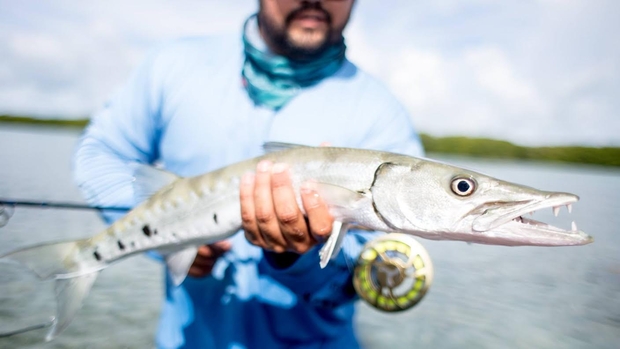Original source: Hatch Magazine
Bonefish are on the decline in the Florida Keys. So are the fish that eat them. Barracuda, once a traditional target of winter flats fishing, are now scarce.
“I just started guiding in 2000, which is not long in the whole scheme of things,” Key West guide John O’ Hearn said. “In the winter you could go to any flat and have a few cudas on it, even if it wasn’t a good flat. You could go anywhere and there would be barracudas. Over the years, you had to get better and better [at finding them]. There are places still with good barracuda fishing. You just have to keep working harder and harder.”
 Photo: Dan Decibel
Photo: Dan Decibel
With so few fish, O’Hearn and other colleagues in the Lower Keys Guides Association started a Save the Barracuda Campaign and urged the Florida Fish & Wildlife Conservation Commission to implement harvest regulations to protect the saltwater predator.
The FWC, which held two meetings for public discussion the issue this winter, is expected to present a draft rule to its commission this fall.
“It’s important in a lot of ways,” said O’Hearn, former president of the LKGA. “In December, January, in the winter time, [barracuda] may be the main target species on the flats when the water gets colder. Obviously, when it’s warm and nice you can go tarpon and permit fishing. In the winter, people coming down are expecting to cuda fish. It’s fun and they’re big, they run and they jump.
“The last five, six, seven years, the numbers have gone down dramatically across the board. We’ve all been talking about it. We’ve all been saying the same thing. They’re fewer and fewer of them.”
According to the FWC, commercial harvest of Keys barracuda has increased significantly the past few years, from 10,000 pounds in 2011 to 50,000 in 2013. Barracuda is considered an unregulated species commercially, meaning commercial fishermen can harvest as much as they want. Recreational anglers are limited to two barracuda or 100 pounds, whichever is greater.
“When you realize how the fish is managed by the state, then you realize it doesn’t make a lot of sense,” said O’Hearn, who credited the LKGA’s Doug Kilpatrick with initially spearheading the barracuda issue. “What we’re seeing, anecdotal or not, is a dramatic difference in the numbers. You have a fish with commercial viability with no commercial regulations.”
Although barracuda is not considered popular table fare in the United States, it is considered a delicacy in the Caribbean. Barracuda, O’Hearn said, typically sell for $1.50, $2 a pound. However, he stressed the LKGA is not blaming commercial fishermen for the dwindling population.
“We’re not trying to point our fingers at commercial fishing by saying that’s why they’re disappearing,” O’Hearn said. “Nobody knows. The state is not going to find out. It should be up to the state to make rules that make more sense. It’s absurd to have a commercial fish where there’s no limits. It doesn’t take a rocket scientist to figure out that’s a recipe for disaster.”
Other conservation groups have taken notice, including Bonefish & Tarpon Trust.
“They’re a high-level predator, so there’s a lot of interaction [on the flats],” Dr. Aaron Adams, the operations director of BTT, said. “People say that with less barracuda, there’s more bonefish, but there’s a balance in the system. Taking out a component of a balanced system can have unintended consequences. The best bonefish fisheries have an intact ecosystem that includes predators. Losing barracuda in the Keys adds another symptom to the overall illness.”




